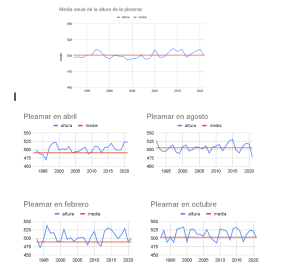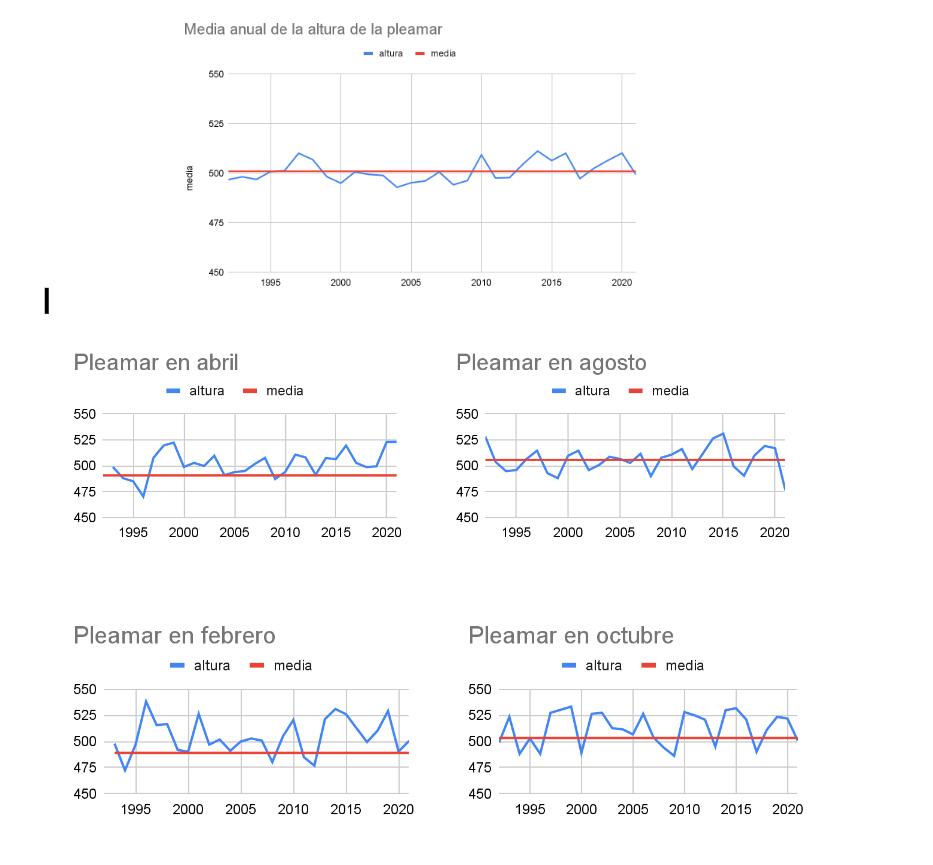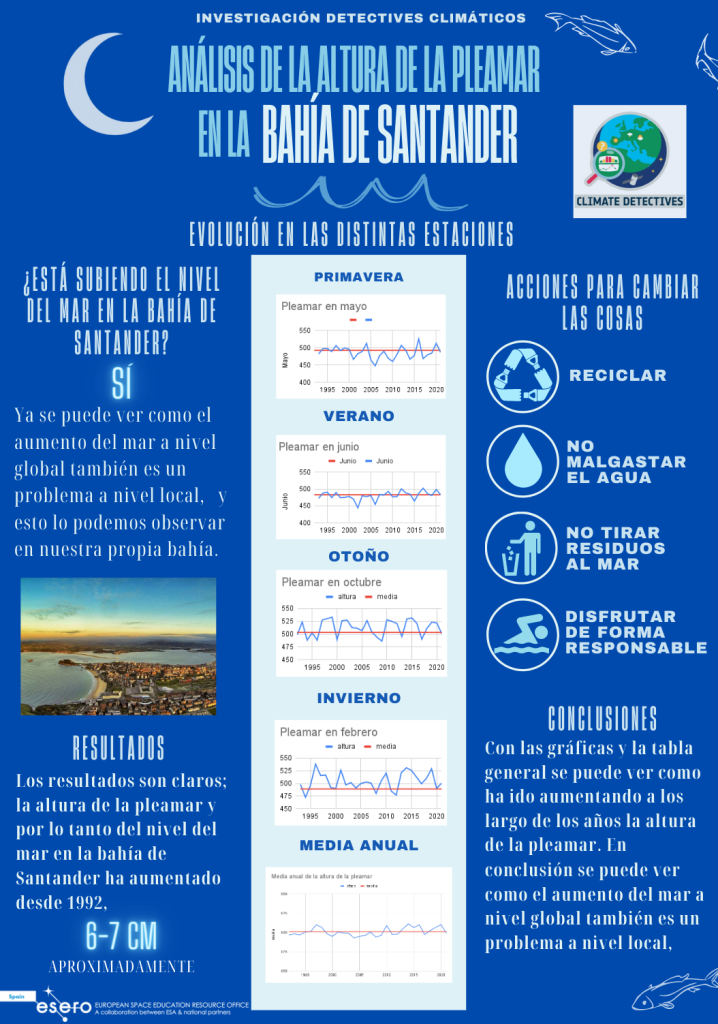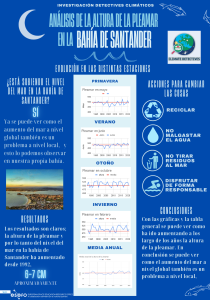Climate Detectives Projects 2022-2023
Project title: The change in the height of the high tide in the Bay of Santander
Team: Castroverde B
C. Tetuán, 47 Santander Spain 3 Student’s age: 14-15 years old
Is the sea level rising in Santander Bay?
¿Está subiendo el nivel del mar en la bahía de Santander?

In this paper we have investigated whether sea level has risen in Santander Bay in recent years. Our hypothesis is that the height of the high tide can be a valid indicator for the problem under investigation, which is to see if climate change has had something to do with the rise in sea level. To find an answer to this question, we have analysed the maximum high tide height from 1992 to 2021, with quantitative data obtained from the Santander tide gauge.
In recent years, current CO2 emissions have warmed the planet to the point where the poles have melted and glaciers have retreated. The rate of climate change, intensified by human action, has raised global sea levels by 7 cm since 1993 and by 19 cm since 1900, as reported by the US government in its Climate Science Special Report (CSSR) written by the Federal Science Steering Committee (SSC), which has representatives from three agencies (the National Aeronautics and Space Administration [NASA] and the Department of Energy [DOE]); hence the three lead authors and coordinators, all of whom were federal employees during the development of this report.
We were already aware of this problem on a global level, but with this research we wanted to find out if it was already noticeable on a local level, i.e. in our bay.
In order to analyse the study of the maximum height of the high tide on the coast of Santander and to be able to see the local data, we have used data from the Puertos del Estado website ( consultations on 21 and 25 April 2023).
En este trabajo hemos investigado si el nivel del mar ha subido en la bahía de Santander en los últimos años. Nuestra hipótesis es que la altura de la pleamar puede ser un indicador válido para el problema investigado, que es poder ver si el cambio climático ha tenido algo que ver en la subida de la altura del mar. Para encontrar una respuesta a esta pregunta, hemos analizado la altura máxima de la pleamar desde el año 1992 hasta el año 2021, con los datos cuantitativos obtenidos del mareógrafo de Santander.
En los últimos años las emisiones actuales de CO2 calentaron el planeta hasta propiciar el deshielo de los polos y el retroceso de los glaciares. La velocidad a la que avanza el cambio climático, intensificada por la acción del hombre, ha elevado el nivel del mar a nivel global unos 7 cm desde 1993 y unos 19 cm desde 1900, según recogió el Gobierno de EE.UU. en su informe Climate Science Special Report (CSSR) escrito por el Comité Directivo Científico Federal (SSC) El cual tiene representantes de tres agencias (La Administración Nacional de Aeronáutica y del Espacio [NASA] y el Departamento de Energía [DOE]); De aquí los tres autores principales y coordinadores, los cuales eran empleados federales durante el desarrollo de este informe.
Ya era de nuestro conocimiento este problema a nivel global, sin embargo con esta investigación queríamos saber si ya era notable a nivel local, es decir en nuestra bahía.
Para analizar el estudio de la altura máxima de la pleamar en la costa de Santander y poder ver los datos locales, hemos utilizado datos de la web de Puertos del Estado. ( consultas el 21 y 25 de abril de 2023)

The main results of our research can be seen in table 1, which shows the evolution of the high tide over time (1992-2021). If we analyse the table we realise that during 1997-1998 there was a rise in the height of the high tide, however during the following ten years the height is below the average, until from 2010 until 2021 there are several peaks above the average.
The results are clear; the height of the high tide and therefore of the sea level in Santander Bay has increased since 1992 by approximately 6-7cm.
Another important result we have obtained from our research can be seen in the randomly selected monthly graphs.
From these graphs we can see that during the summer and autumn months the graphs are not striking, however during the winter and spring it can be seen that the high tide height increases, as both graphs have a large number of above average peaks.
The conclusions are that, yes, the sea level in the Bay of Santander has risen in recent years. The graphs and the general table show how the height of the high tide in the bay has been increasing over the years. In conclusion, we can see how the global rise of the sea is also a problem at a local level, as we can observe it in our own bay.
Los principales resultados de nuestra investigación se pueden apreciar en la tabla 1, la cual muestra la evolución de la pleamar a lo largo del tiempo (1992-2021). Si analizamos la tabla nos damos cuenta que durante 1997-1998 hubo una subida de la altura de la pleamar, sin embargo durante los siguientes diez años la altura se sitúa por debajo de la media, hasta que a partir del 2010 hasta el 2021 hay varios picos por encima de la media.
Los resultados son claros; la altura de la pleamar y por lo tanto del nivel del mar en la bahía de Santander ha aumentado desde 1992, aproximadamente entre 6-7cm.
Otro importante resultado que hemos obtenido de nuestra investigación, se puede apreciar con las gráficas mensuales elegidas aleatoriamente.
Con estas gráficas podemos ver que durante los meses de verano y otoño las gráficas no llaman la atención, sin embargo durante el invierno y la primavera se puede observar que la altura de la pleamar aumenta, ya que ambas gráficas tiene un gran número de picos por encima de la media.
Las conclusiones son que sí, el nivel del mar en la bahía de Santander ha aumentado en los últimos años. Con las gráficas y la tabla general se puede ver como ha ido aumentando a los largo de los años la altura de la pleamar en la bahía. En conclusión se puede ver como el aumento del mar a nivel global también es un problema a nivel local, ya que lo podemos observar en nuestra propia bahía.

We believe that the basis for solving the problem is to raise awareness among the future adult population, i.e. children, with talks and projects to raise awareness of the problem we are facing. However, we believe that it is not enough to give a talk, for something to attract attention it has to have an impact, so our idea is that in addition to the talks, in schools, there should be practical work in laboratories on the greenhouse effect, among other things.
Another idea is to educate everyone better, especially women, who if educated, especially in less developed countries, would have fewer children and at a younger age, which would have a good environmental impact.
On an individual level, we believe that everyone should take the following steps:
Use public transport, or transport that does not produce gas emissions, whenever possible.
Make more use and disseminate the use of renewable energy sources, such as photovoltaic panels.
Consume less, make more use of the reuse or recycle method.
In houses, premises or schools, use energy-saving or sustainable light bulbs.
Reduce water use by taking showers instead of baths or turning off the tap when brushing our teeth.
Separate the rubbish, and dispose of it in the appropriate rubbish bin.
Reuse plastic, such as plastic bags or plastic bottles, or better if we don’t make use of it with cloth bags instead of plastic.
Nosotros creemos que la base para solucionar el problema es concienciar a la futura población adulta, es decir los niños con charlar y proyectos para dar a conocer el problema al cual nos enfrentamos. Sin embargo creemos que no basta con dar una charla, para que algo llame la atención tiene que ser impactante, por lo que nuestra idea es que se hicieran además de las charlas, en los colegios, se hicieran prácticas en los laboratorios sobre el efecto invernadero entre otros.
Otra idea es educar mejor y a todo el mundo, en especial a las mujeres las cuales si fueran educadas, sobre todo en los países menos desarrollados, estas tendrían menos hijos y a edades menos tempranas, lo cual tendría un buen impacto medioambiental.
A nivel individual creemos que todos deberiamos tomar las siguientes medidas:
Utilizar siempre que se pueda el transporte público, o un transporte que no produzca emisiones de gas.
Hacer más uso y divulgar la obtención de energía a través de las energías renovables, como paneles fotovoltaicos.
Consumir menos, hacer más uso del método de reutilizar o reciclar.
En las casas, locales o colegios poner bombillas que consumen menos o que sean sostenibles.
Reducir el uso de agua, duchándonos en vez de bañarnos o cuando nos lavemos los dientes apagar el grifo.
Separar la basura, y tirarla en cada basura correspondiente.
Reutilizar el plástico, como las bolsas o las botellas de plástico o mejor si no hacemos usos de esta con bolsas de tela en vez de plástico.
This project was automatically translated into English.
Projects are created by the teams and they take the full responsibility of the shared data.
← All projects





